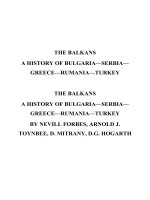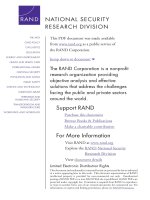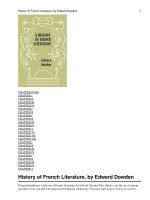arranging the meal a history of table service in france university of california press (2007)
Bạn đang xem bản rút gọn của tài liệu. Xem và tải ngay bản đầy đủ của tài liệu tại đây (3.22 MB, 244 trang )
Arranging the Meal
c a l i f o r n i a s t u d i e s i n f o o d a n d c u lt u re
Darra Goldstein, Editor
1. Dangerous Tastes: The Story of Spices, by Andrew Dalby
2. Eating Right in the Renaissance, by Ken Albala
3. Food Politics: How the Food Industry Influences Nutrition and Health, by
Marion Nestle
4. Camembert: A National Myth, by Pierre Boisard
5. Safe Food: Bacteria, Biotechnology, and Bioterrorism, by Marion Nestle
6. Eating Apes, by Dale Peterson
7. Revolution at the Table: The Transformation of the American Diet, by Harvey
Levenstein
8. Paradox of Plenty: A Social History of Eating in Modern America, by Harvey
Levenstein
9. Encarnación’s Kitchen: Mexican Recipes from Nineteenth-Century California:
Selections from Encarnación Pinedo’s El cocinero español, by Encarnación
Pinedo, edited and translated by Dan Strehl, with an essay by Victor Valle
10. Zinfandel: A History of a Grape and Its Wine, by Charles L. Sullivan, with a
foreword by Paul Draper
11. Tsukiji: The Fish Market at the Center of the World, by Theodore C. Bestor
12. Born Again Bodies: Flesh and Spirit in American Christianity, by R. Marie
Griffith
13. Our Overweight Children: What Parents, Schools, and Communities Can Do to
Control the Fatness Epidemic, by Sharron Dalton
14. The Art of Cooking: The First Modern Cookery Book, by The Eminent Maestro
Martino of Como, edited and with an introduction by Luigi Ballerini, translated and annotated by Jeremy Parzen, and with fifty modernized recipes by
Stefania Barzini
15. The Queen of Fats: Why Omega-3s Were Removed from the Western Diet and What
We Can Do to Replace Them, by Susan Allport
16. Meals to Come: A History of the Future of Food, by Warren Belasco
17. The Spice Route: A History, by John Keay
18. Medieval Cuisine of the Islamic World: A Concise History with 172 Recipes, by
Lilia Zaouali, translated by M. B. DeBevoise
19. Arranging the Meal: A History of Table Service in France, by Jean-Louis Flandrin,
translated by Julie E. Johnson, with Sylvie and Antonio Roder
Arranging the Meal
a h i s to ry o f ta b l e s e rv i c e i n f r a n c e
Jean-Louis Flandrin
Translated by Julie E. Johnson
with Sylvie and Antonio Roder
Foreword to the English-Language Edition by Beatrice Fink
university of california press
berkeley
los angeles
london
The publisher gratefully acknowledges the generous contribution to this book provided by
the General Endowment Fund of the University of California Press Foundation.
Publié avec le concours du Ministère français chargé de la culture, Centre national du
livre. Published with the assistance of the French Ministry of Culture’s National Center
for the Book.
University of California Press, one of the most distinguished university presses in the United States,
enriches lives around the world by advancing scholarship in the humanities, social sciences, and natural
sciences. Its activities are supported by the UC Press Foundation and by philanthropic contributions
from individuals and institutions. For more information, visit www.ucpress.edu.
Originally published in French as L’Ordre des mets,
© Éditions Odile Jacob, janvier 2002.
University of California Press
Berkeley and Los Angeles, California
University of California Press, Ltd.
London, England
© 2007 by The Regents of the University of California
Library of Congress Cataloging-in-Publication Data
Flandrin, Jean-Louis.
[Ordre des mets. English]
Arranging the meal : a history of table service in France / Jean-Louis Flandrin ; translated by Julie
E. Johnson with Sylvie and Antonio Roder ; foreword to the English-language edition by Beatrice Fink.
p.
cm.
Includes bibliographical references and index.
isbn 978-0-520-23885-5 (cloth : alk. paper)
1. Food habits—France—History. 2. Dinners and dining—France—History. 3. France—Social
life and customs. 4. Food habits—England—History. 5. Food habits—Poland—History. I. Title.
GT2853.F7F63 2007
394.1'20944—dc22
2007007628
Manufactured in the United States of America
16
10
15 14 13 12 11 10 09 08
9 8 7 6 5 4 3 2 1
07
This book is printed on New Leaf EcoBook 50, a 100% recycled fiber of which 50% is de-inked
post-consumer waste, processed chlorine-free. EcoBook 50 is acid-free and meets the minimum
requirements of ansi/astm d5634–01 (Permanence of Paper).
co n t e n ts
Plates follow page
108
f o r e w o r d , by Georges Carantino
vii
foreword to the english-language edition:
j e a n - l o u i s f l a n d r i n’s w o r l d o r d e r,
by Beatrice Fink
preface
ix
xix
pa rt o n e
the structure of meals in the classical age
1
/
Composition of the Classical Meal
2
3
4
/
/
/
Roasts
3
12
Entrées and Entremets
Composition of Meatless Meals
21
32
1
pa rt t w o
f o u rt e e n t h t o t w e n t i e t h c e n t u r i e s : va r i at i o n s
45
in the sequence of courses in france
5
/
French Meals in the Fourteenth and
Fifteenth Centuries
47
6
/
Sixteenth-Century Overview
7
8
/
9
/
57
Classical Order in the Seventeenth and
Eighteenth Centuries
72
Innovations from the Revolution to World War I
/
Hidden Changes in the Twentieth Century
90
106
pa rt t h r e e
other countries, other sequences
10
11
/
/
English Menu Sequences
109
111
Polish Banquets in the Sixteenth, Seventeenth, and
Eighteenth Centuries
118
postscript
127
appendixes
131
A. Additional Material for Part Three
131
B. Dietetics and Meal Sequences
136
C.The Cuisine of the Renaissance
149
D. Additional Printed Sources
153
notes
159
195
works cited
index
199
f o rewo rd
Georges Carantino
Jean-Louis Flandrin had finished writing more than three-quarters of this
book, originally published in France as L’Ordre des mets, by the time he
passed away in August 2001. The knowledge that it would present the conventions of the table in a totally new light must have driven him, in the last
months of his life, to see it completed. This act of will surely helped him
carry on for nearly a year in spite of the illness that eventually overcame
him. It is with gratitude that we acknowledge here the contribution of his
closest students, who sustained and assisted him in his final effort.
Having often discussed his book and its outline with him, we were
steeped in his approach and reasoning, but would never take it upon ourselves to finish it in his stead. Nevertheless, being familiar with his other
writings and comments on the subject, we supplemented the completed
portion of his manuscript with selections in which he presents the traditional structure of meals in other European countries and ponders the reasons behind these customs. Many of the points he would have wished to
make will no doubt be lost, but to presume to speak for him—not that anyone could—was unthinkable.
While this book establishes a few axioms, it may also inspire new questions and new discoveries. There could be no greater tribute to its author.
Georges Carantino is a historian, a former student of Jean-Louis Flandrin, and now president
of De Honesta Voluptate, Société des Amis de Jean-Louis Flandrin (Friends of Jean-Louis
Flandrin Society).
vii
This page intentionally left blank
f o rewo rd to t h e e n g l i s h - l a n g uag e e d i t i o n
Jean-Louis Flandrin’s World Order
Beatrice Fink
Bernard Loiseau’s dramatic disappearance from the French culinary scene
in February 2003—like his illustrious forebear Vatel he committed suicide
rather than experience the downfall of his reputation as a chef—generated
impressive tremors throughout France. The great culinary artist was declared a martyr by those wishing to undermine the all-powerful restaurant
critics’ Diktats. “Regicides” was the term used by one of Loiseau’s followers to characterize this tyrannical cohort. More significantly, this chef extraordinaire was given a hero’s farewell by his horde of admirers. His funeral
was the occasion for what amounted to a summit meeting of France’s culinary crème de la crème. For the thousands unable to enter the small church
at Saulieu in which the funeral was held, the ceremony was projected on a
huge outdoor screen.
Had Jean-Louis Flandrin been alive, he would have been elated at such
a projection of cuisine’s grandeur, and would in all likelihood have been
among the privileged few invited to attend the funeral service inside the
church. Flandrin was a luminary in his own right, not only in his capacity
as a member of France’s exclusive—at times elusive—image-conscious gastronomic elite, but also as a standard bearer of Academe, more precisely as
someone who had devoted a sizable part of his professional career to teaching, researching, writing on, and otherwise fostering all aspects of food in
historical perspective. The context he drew on knew no limits: his real and
ix
not-so-secret grand design was to carve out a niche for himself as a
renowned authority on what he termed historical anthropology, thus tying
together the various strands of his work on family structures, sexuality, and,
as one of his subtitles suggests, ethnology of the meal.1 As cook and entertainer par excellence in his own home, as conceiver and overseer of period
meals with an emphasis on the Renaissance era, he fitted into the world of
practitioners. As scholar and searcher of meanings, he inclined toward the
realm of the theoreticians. In one of his food seminars I happened to attend,
Flandrin delighted in pointing out the conflation of language and tongue,
the linguistic and the gustatory. Historical dictionary in hand, he exclaimed, “Look at all the words in the food lexicon beginning with the letter g: goût, gourme, gourmet, gourmand, gastronome, glouton . . .” One might
say, consonance for consonance, that Flandrin the scholar was in search of
an archetypal order tying together les mets, les mots, et les mœurs (dishes,
words, and mores).
Unsurprisingly, my first contact with the author was occasioned by a dinner. Not just any dinner. It was in celebration of Easter, invariably a festive
occasion in his wife’s native Poland. The year was 1980. A mutual friend and
colleague had mentioned my culinary interests to the Flandrins, which
prompted them to invite me to their holiday feast, sight unseen. There were
half a dozen or so of us gathered around the dining table. The setting, in
all senses of the term, was one of high drama and anticipation. One of the
guests turned out to be a food critic on the staff—I remember my host’s insistence on this fact—of a leftist newspaper. This was significant, because
at that time an important change was in the air. La droite (the political
right) was no longer the sole turf of the gastronomic scene. A postwar shift
had taken place, and for the left it became fashionable, at first in a radicalchic way, then more systematically, to become an aficionado of things gastronomic. Haute cuisine and its concomitants—celebrated chefs, starbedecked restaurants, grands crus, and the like—while fully maintaining
their traditional prestige as status symbols, were no longer being associated
with a particular social class or political milieu, but had been embraced by
a much wider social spectrum, in the process producing a cultural conflation of conservative and mobility-oriented France. This phenomenon was
reminiscent of a shift that had occurred two centuries earlier, when the fine
art of preparing dishes and of connoisseur dining became accessible not
only to the private sphere (largely upper nobility) but also to the public
(mostly well-to-do bourgeoisie). This was almost entirely the outgrowth of
x
b e at r i c e f i n k
the restaurant’s coming of age in postrevolutionary France. The food critic
guest in question, I should add, was suitably informally garbed, with the
obligatory foulard draped over his shoulder.
Aside from this venture into the contemporary social climate, the Easter
meal, while retaining a suitable historical component (the gigot or roast leg
of lamb, for instance, was larded not with the usual garlic but with tiny bits
of cornichons—French mini-pickles—as was customary, according to
Flandrin, in sixteenth-century France), was first and foremost a guessing
game. What, the guests were asked, was the principal ingredient of the multitextured soup we were served? It turned out to be a special variety of cabbage. Alongside the main lamb dish, we were served a small bowl of something resembling, in appearance and consistency, pieces of artichoke hearts
whose taste, I conjectured, had been modified by various seasonings. The
answer, which no one arrived at, turned out to be a beef palate that his wife,
Maria, emitting a great sigh, informed us had simmered for more than
twenty-four hours so as to render the cartilaginous palate palatable. It was
likewise a road sign pointing to the French cookery of yesteryear, when it
was not uncommon to use parts of a beef’s head (jowls, palate, snout, even
ears) in various dishes, whereas today this part of the animal tends to be
used exclusively in charcuterie. And so it went from beginning to end with
this memorable prandial guessing game, not to mention the sorbet dessert
subtly flavored with champagne.
Flandrin’s playful side was manifest in other types of challenges. Being
acquainted with my anglophone background, he would question me on arcane English terms: What does the word neats designate in cookery? This
was thrust at me orally, that is to say, without benefit of spelling. Having
recently returned from Scotland, I unhesitatingly answered, “Rutabaga.”
“Oh?” he replied. Shortly thereafter, I realized that I had confused neeps, a
Scottish term for large yellow turnips, with neats, a now-obsolete designation for oxen, bullocks, or cattle and, by British culinary extension, their
feet (beef trotters?), once again according to Flandrin. Needless to say, I became as flushed as a piece of raw beef, avoiding the twinkle in my inquisitor’s eye.
Whenever I visited the Flandrins, there were exquisite goodies to eat or
drink. The last time I saw the author alive, the occasion being an article he
was working on for a special food issue I was preparing for publication, a
young Moroccan student happened to drop by, bearing mouthwatering
pastries from his homeland (he had been working on a dissertation under
Flandrin’s directorship).2 These precious tidbits were immediately passed
foreword to the english-language edition
xi
around and shared. Such visits were far from rare, since Flandrin held a
quasi-permanent open house for his diverse array of students and was
clearly both venerated and beloved by them. Former students Philip and
Mary Hyman, an American couple who live and work in France, are currently culinary consultants of note and have been tasked by the French government to record French culinary history region by region. Another former student, Georges Carantino, took it on himself to put together and edit
the present work, continue his mentor’s unique food history seminar, and
head De Honesta Voluptate, Society of the Friends of Jean-Louis Flandrin.3
I won’t ever forget how on the occasion of that last visit the then-ailing historian (several major operations had left the cancer-stricken scholar with reduced mobility and strength) insisted on going by himself to the new, and
at that time still unfriendly for the less mobile, Bibliothèque nationale in
order to check on and complete several references for the article to be included in my special issue. Nor have I forgotten how, several years earlier,
he had given me a lovely little cookery book full of health-maintenance
recipes and tips on which kinds of processed edibles should be avoided because they were said to contain health hazards.
Jean-Louis’s wife, Maria, while also a historian, did no joint research with
him but was his inseparable companion and, when health problems got the
better of him, watched over him with a hawk’s eye. No more hawkish, however, than the gaze both of them directed toward their two pet dogs, Finek
and Grisby. These two vocal mischief makers were ever on the move, and
the Flandrins were ever taking them for walks, feeding them dainty (doubtless period gourmet) morsels, and—confided Maria when I went to see her
shortly after her husband’s death—spoiling them outrageously. Visitors approaching the Flandrins’ front door from down the hall would hear the
dogs barking. Clearly, they were a therapeutic distraction that kept the
Flandrins’ minds off their mounting health problems.
The kitchen, however, reigned supreme in their lives. Be it never forgotten that in eighteenth-century France cuisine had been elevated to the rank
of a fine art, where it remains to this day.
Flandrin’s open-house policy was equally an open-door policy. Maria
told me that her husband, ever sensitive to those who appeared undernourished, once returned to their apartment with a homeless person he had
come across on the street and invited to a meal. Watching another fill an
empty stomach was for the food historian a source of great satisfaction.
I had always been in awe, and more than a little envious, of Flandrin’s
impressive personal library. Bookshelves, often two rows deep, lined the
xii
b e at r i c e f i n k
walls of his study as well as other areas of the apartment. There were, of
course, the rows and piles of general and of specialized reference books
alongside recent and less-recent publications in the field to be expected in
any respectable scholar’s working library, especially if he or she happens to
be a historian. But what attracted me were those precious gems usually
found only in the rare-book reserves of a few privileged libraries, and even
then not always, not all, and to be handled only under a variety of constraints. Just try to find and, moreover, purchase one of these gems at a
rare-book dealer’s, at auction, or by some other means! If you are fortunate enough to locate what you are seeking and it is in good condition,
your eyes will pop when you find out the price. I’m referring not only to
leather-bound period editions of early food-related works but also, and
more especially, to those wonderfully useful and infinitely caressable (even
though most are bulky folio editions) historical dictionaries, encyclopedias, almanacs, and other assemblages of knowledge and language at a specific point in time. Arguably, nowhere did matters of food and food preparation, nutrition, or the fine art of cookery make greater inroads in such
books during the “long” eighteenth century than in France. Flandrin possessed several, in particular one of the eighteenth-century editions of the
famed Dictionnaire de Trévoux, whose Jesuit editors were involved in more
than one polemic as concerned matters of food and recipes with those of
Diderot’s Encyclopédie.4 The Dictionnaire de Trévoux has always been an invaluable research tool for me, as well as a tangible link with a prized culinary epoch.
Generous with his books as in other matters, Flandrin, his wife informed
me, had donated the greater portion of his library to the Maison des sciences de l’homme, a prestigious social sciences learning and research center located in the heart of Paris.5 His manuscripts and other assorted documents have been deposited in France’s Archives nationales. Needless to
say, an endless number of articles remain encased in learned journals, volumes of Proceedings, and Festschriften. Dog-eared copies of books Flandrin had himself authored naturally remained on his own bookshelves
(eleven in all according to the Bibliothèque nationale de France catalog, several in multiple editions and/or translated into other languages, some coauthored or edited). The most recent, and presumably the last, is a charming
posthumous booklet on the quintessentially French blanquette de veau that
amounts to an ode in praise of a classic French dish. L’Ordre des mets, as the
original French edition of this book is titled, is thus not last on the list of
Flandrin’s publications, but rather the penultimate. It is, however, the final
foreword to the english-language edition
xiii
panel of his unfinished magnum opus, of his not-quite-completed dream
of constructing an ethnology of the meal.
I return to the term unfinished. The reader may be taken aback by a book
whose table of contents, from chapter 9 on, gives the appearance of being
fragmented and even somewhat disjointed. There is, however, method in
this seeming chaos. Georges Carantino points out in the preceding foreword that in undertaking the task of completing Flandrin’s thought without in any way modifying, abridging, or adding to the author’s original
text, he and a select group of students were not only thoroughly familiar
with the author’s intentions but were likewise sufficiently cognizant of his
writings as a whole to be able to locate fragments in various stages of completion that deal with the ordering of meals in countries other than France,
as well as the author’s attempts at an explanation. The same holds true for
the material in the appendixes.
While the inclusion of an English component in the body of the text is
hardly surprising, given the many connections across the centuries between
English and French table mores, the interjection of a Polish one may strike
the reader as unseemly. Again, this inclusion is not happenstance. For one,
there is more than a single historical tie between France and Poland. More
important, the author’s wife, as mentioned above, comes from Poland,
which might explain the historian’s special interest in, and knowledge of,
that nation’s prandial culture. Reminiscing about the legendary Easter dinner held at the Flandrins’ in 1980, I questioned Maria during one of my visits about Polish festive meal traditions. At Eastertide, she replied, there were
no specific dishes or rituals (except for the eggs), but the meal was bound
to be a fine one, because Easter marked the end of Lent, a period of abstinence taken very seriously by Polish Catholics to this day. The case was
different for Christmas. On Christmas Eve, a lean meal is customary, most
likely including herring, salted cucumbers, and some form of vegetable
soup in copious quantities. A roast-centered meal with trimmings is reserved for Christmas Day, the grand finale consisting of some mouthwatering variety of poppy-seed dessert. In L’Ordre des mets, chapter 11 deals
with Polish banquets from the sixteenth century to the eighteenth, including how and in which order the dishes were served, according to the observations of French travelers. While the ordering may have changed,
soups and poppy-seed preparations were even then much in evidence.
England and Poland, each for its own reasons, clearly ranked high on
Flandrin’s non-France priority list. Regrettably, Italy, with its all-important
contributions to prandial history, is one of the missing pieces, except for
xiv
b e at r i c e f i n k
some ultrabrief notations on Italian Renaissance meals. The subordination
of topography to chronology, at least in the present work, may be explained
not only by the fact that its author was a historian but, more significantly,
by the fact that “other” meal tables are given extensive coverage in a collection of articles coedited by Flandrin and published shortly before his
death.6 These include, aside from a substantial article by Allen J. Grieco on
Italian meals in the late medieval and Renaissance periods, a contribution
over eighty pages in length by Flandrin himself titled “Meals in France and
the Other Countries of Europe from the Sixteenth to the Nineteenth Centuries.”7 In these pages as elsewhere, Flandrin’s gaze invariably focused on
the how, when, where, and why of meal order and on attendant questions
of civility. Aside from this group of articles, two previous publications
brought up the subject: parts of Flandrin’s seminal edition of essays on Histoire de l’alimentation and a section of the beautifully illustrated book on
medieval gourmand feasts he coauthored with C. Lambert that deals with
matters of ordonnance.8
Ordonnance is a French substantive derived from the verb ordonner (“to
arrange, to order, to put in order”) designating not only order, but also disposition, grouping, enactment, and, by medical extension, a prescription.9
Flandrin’s use of the word ordre is to be understood in this polysemic sense,
far outreaching its mere denotation of “sequence.” The subject of a meal’s
successive dishes is certainly not original and has appeared in many writings, typically travelers’ journals, memoirs, or correspondence. But such
treatment of meals nearly always stops short of systematic analysis and is reduced to a partial, more or less detailed description, interspersed with sporadic comments, comparisons, or exclamations. Flandrin’s search for a logic
underlying meal structures in terms of dishes—be it cultural, medicinal,
nutritional, culinary, religious, or consisting merely of random factors in no
way attributable to discernible logical constructs—was an undertaking as
ambitious as it was original. Going beyond compilation and empirical observation, Flandrin attempted to synthesize. While some of the questions
he raised remained unanswered (thus pointing to future fields of inquiry),
a method in cultural modes was more often detected than not. Why, where,
when, and how are the fat/lean controversies resolved or the shifting lines
dividing the two set straight? Where are the determinants of hot-to-cold or
cold-to-hot mutations in dish order to be found? How does the dialectic of
light versus rich foods work itself out? Why do some cultures drink during
the meal and others only after? When do sweet and savory merge and when
do they not? And why or where does sweet not follow but precede savory?
foreword to the english-language edition
xv
Among less-inspected areas is that of the nature of serving. Service à la
française or service à la russe? Flandrin has provided a revealing look at this
fundamental nineteenth-century shift from a paradigmatic (clustered) to a
syntagmatic (sequential) pattern in the serving of dishes at the meal table,
punctuated with practical and aesthetic considerations emanating from
contemporary observers. In the fragments of what was intended to be the
conclusion to his book, Flandrin noted not only the frequent convergence
of principles and practices in meal modes across time and space but also the
many contradictions or paradoxes that are still to be resolved. So be it, and
so it is with all far-reaching endeavors.
There is an old French proverb that says one should have a bit of appetite
left when leaving the table. Flandrin’s eye-opener does just that. The proof,
by the way, is in the pudding. A three-day international conference honoring Flandrin took place at the University of Paris/Vincennes at the end of
September 2003. Titled “Le Désir et le goût: Une autre histoire,” its published version has recently appeared.10 It will surely provide much postprandial nourishment.
n ot e s
1. Tables d’hier, tables d’ailleurs: Histoire et ethnologie du repas, ed. Jean-Louis
Flandrin and Jane Cobbi (Paris: Éd. Odile Jacob, 1999).
2. The Cultural Topography of Food, a special issue of Eighteenth-Century Life
23, no. 2 (May 1999). The article in question is titled “L’Invention des grands vins
français et la mutation des valeurs œnologiques,” pp. 24–33.
3. In the original French: De Honesta Voluptate, Société des Amis de JeanLouis Flandrin. The current president is Patrick Rambourg. The SAJLF, as it is
familiarly referred to, holds regular seminars during the academic year involving
high-level specialists in the field and holds a yearly period-meal banquet with
dishes prepared by SAJLF members.
4. Diderot was (justifiably) accused by the Dictionnaire de Trévoux’s editors of
having swiped certain recipes from their publication. Diderot in turn pointed
out that the Jesuits had plagiarized parts of Father Noël Chomel’s early
eighteenth-century Dictionnaire économique. The finger-pointing was ongoing.
5. This is where Flandrin’s seminars were held, and currently those of the
SAJLF. The quasi-remainder of his library was subsequently donated to the MSH
by his wife.
6. Tables d’hier, tables d’ailleurs.
7. My translation.
8. Histoire de l’alimentation has been translated into English as Food: A Culxvi
b e at r i c e f i n k
tural History; J.-L. Flandrin and C. Lambert, Fêtes gourmandes au moyen âge
(Paris: Imprimerie nationale, 1998).
9. As once did receipt, better known under its present name, recipe.
10. Le Désir et le goût: Une autre histoire, ed. F. Joannes, P. Lantz, and O.
Redon (Paris: Presses Universitaires de Vincennes, 2005).
foreword to the english-language edition
xvii
This page intentionally left blank
p re fac e
In France, it is generally understood that the elements of a meal are to be
served in a particular order. As they wait to be seated, guests are first kept
happy with drinks. Accompanying savories stimulate thirst and buffer the
effects of the alcohol. At the table, the meal proceeds with soup, cold appetizers, and/or hot dishes, followed by the main course of meat or fish with
vegetables, then salad, cheeses, dessert, and, lastly, coffee and after-dinner
drinks. No one questions this prescribed order. Exceptionally, the salad is
sometimes served as an hors d’oeuvre, with tiny goat cheeses specially
warmed for the occasion.
Yet, as the French discover the moment they cross national borders, this
order of presentation is neither preordained nor universal: in Italy, pasta is
invariably the first course, and cold vegetables such as peppers in oil may
be served either as appetizers or as vegetable dishes. In England, cheese is
generally served after fruit rather than before. In the United States, coffee
with cream, iced tea, and even soft drinks are offered with just about every
meal, whereas the French drink café au lait only at breakfast or between
meals. In Poland, Turkey, and China, people drink no liquids with their
main meal but like to end it with a hot broth or cold fruit soup, washed
down with a big thirst-quenching cup of tea.
The sequence in which dishes are served is a cultural rather than natural
ritual that has evolved over centuries in most countries, including France.
xix
This book presents the history of this evolution. It begins with the seventeenth and eighteenth centuries, when French tradition was at its most elaborate and strict; it then examines the customs preceding and following this
golden age, from the last two centuries of the Middle Ages to the present.
Next, various periods in several other European countries are considered.
Finally, this study explores the reasons behind the order in which meals
were served in different periods. The rationales that were given at the time
are compared to actual practices, both in France and in neighboring lands.
As it turns out, various countries cited the same principles as the basis for
quite different meal sequences. This book explains why.
xx
preface
part one
The Structure of Meals in the
Classical Age
This page intentionally left blank
one
Composition of the Classical Meal
co u r s e s a n d ot h e r p re s c r i b e d s tag e s o f t h e m e a l
Today, dishes are served one after the other, so their order of consumption,
whatever it may be, is clear. Such was not the case for the service à la
française meal etiquette that prevailed until the mid-nineteenth century.
At the time, formal meals consisted of several “courses”—usually three
or four but at times five or more—each composed of several dishes brought
to the table at the same time. Here is how A.-B.-L. Grimod de La Reynière
describes such a meal in his 1805 Almanach des gourmands: “An important
dinner normally comprises four courses. The first consists of soups, hors
d’oeuvres, relevés, and entrées; the second, of roasts and salads; the third of
cold pasties and various entremets; and lastly, the fourth, of desserts including fresh and stewed fruit, cookies, macaroons, cheeses, all sorts of
sweetmeats, and petits fours typically presented as part of a meal, as well as
preserves and ices.”1
In describing the different courses, Grimod de La Reynière puts
different types of dishes in the same category. Some are defined by aspect and mode of preparation, like all the desserts he names. Others are
defined by their position and function in the sequence, as in the elements of the first three courses, especially hors d’oeuvres, relevés, entrées, and entremets.2 Entrées, for instance, could vary greatly depend3
ing on their main ingredient, method of preparation, and final appearance, but they were defined by their place in the meal, somewhere between the soup and the roast. Likewise, entremets were very diverse, but
all were served between the roast and dessert and characterized by this
position in the meal.
A number of dishes, such as soups, roasts, and salads, were categorized
in two different ways, both by their content and by their place in the meal.
The essential element of any soup or potage—from the Latin potus, meaning “brew”—was stock, and this is still the primary connotation of the
word. But in the seventeenth and eighteenth centuries, soups were also defined by their place at the very beginning of the meal. In fact, dictionaries
of the period define them in terms of both characteristics, as in the 1704 edition of the Dictionnaire de Trévoux: “Cooked meat juices in which fine slices
of bread are soaked or simmered. Jus, jusculum. Soup is served at the beginning of the meal.” The second part of this definition is probably the
more reliable, because the bread that was simmered in soup could mask its
liquid character—in the eighteenth century, barely liquid pasta and rice
dishes were sometimes presented as soups. A meal for Louis XVI at his castle in Saint-Cloud on 19 May 1788 included “two main soups,” namely,
“Vermicelli” and “Spanish Croutons,” with two secondary ones, Polish
“Clouskis” and “Mixed Croutons.” Such examples abound, as discussed in
the chapters that follow.
Roasts were also classified by their assigned order as well as by the cooking method. The Dictionnaire de Trévoux defines them as “meat roasted on
a spit,” served “at the midpoint of the meal.”
The order and function of salads were more significant than how they
were prepared. The same source describes them as “a sort of entremets
brought to the table alongside the roast. . . . Usually composed of fresh
greens seasoned with salt, oil, and vinegar.” But salad greens—not just fruit
salads—were often seasoned with sugar, and the term salad also applied to
vinegar-pickled purslane and sea fennel, cornichons, cured olives, capers,
anchovies, and quartered bitter oranges served with the roast to refresh a
guest’s appetite.
Despite this dual classification of soups, roasts, and salads as both entrées
and entremets, these two categories must be clearly distinguished. But there
exists no general term for dishes that are defined by their order and function within the meal. Since one must therefore be invented, I propose
“functions.”
4
structure of meals in the classical age









